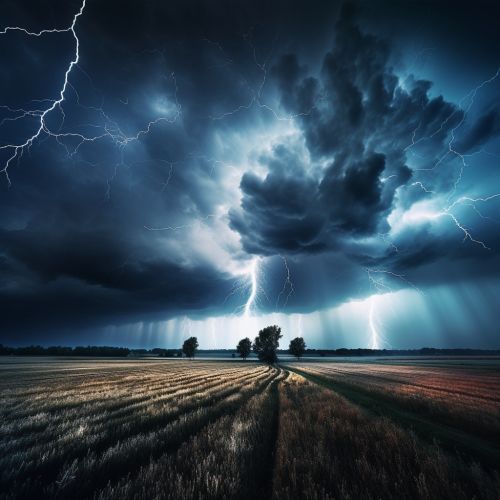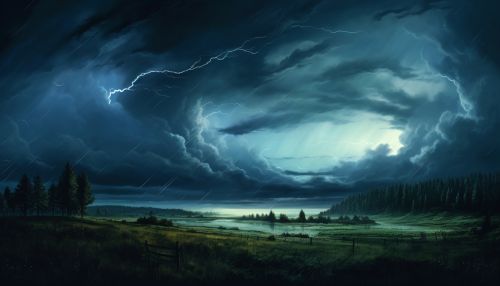Thunderstorm
Introduction
A thunderstorm, also known as an electrical storm, is a meteorological phenomenon characterized by the presence of lightning and its acoustic effect on the Earth's atmosphere, known as thunder. Thunderstorms occur in association with a type of cloud known as a cumulonimbus. They are usually accompanied by strong winds, heavy rain, and sometimes snow, sleet, hail, or, in contrast, no precipitation at all.


Formation
Thunderstorms are formed from the upward movement of warm, moist air. This can occur along warm and cold fronts, along sea breezes, at the base of mountain ranges, or over warm ocean currents. The updrafts carry the warm, moist air upwards, where it cools and condenses to form a cloud. If the updraft is strong enough, it can lift the air to a level where the temperature is below freezing, leading to the formation of hail.
Types of Thunderstorms
There are several types of thunderstorms, including single-cell, multi-cell cluster, multi-cell line (squall line), and supercell. Single-cell thunderstorms are small, brief, weak storms that are not severe and do not produce severe weather. Multi-cell cluster thunderstorms are a group of storms which can produce severe weather conditions such as hail, strong winds, and tornadoes. Squall line thunderstorms are a line of storms that can cover a large area, but are not as severe as a supercell thunderstorm. Supercell thunderstorms are the most severe and can produce some of the most dangerous weather conditions, including large hail, strong and damaging winds, and tornadoes.
Lightning
Lightning is a sudden electrostatic discharge that occurs during a thunderstorm. This discharge occurs between electrically charged regions of a cloud, between two clouds, or between a cloud and the ground. The charged regions in the atmosphere temporarily equalize themselves through the discharge, referred to as a strike if it hits an object on the ground. There are three primary types of lightning; intracloud (IC), cloud to cloud (CC), and cloud to ground (CG).
Thunder
Thunder is the sound caused by lightning. Depending on the distance from and nature of the lightning, it can range from a sharp, loud crack to a long, low rumble. The sudden increase in pressure and temperature from lightning produces rapid expansion of the air surrounding and within a bolt of lightning. In turn, this expansion of air creates a sonic shock wave, often referred to as a "thunderclap" or "peal of thunder".
Hazards
Thunderstorms can cause a number of hazards, including lightning, hail, strong winds, flash floods, and tornadoes. Lightning can cause fires, especially in dry areas. Hail, which can be extremely large, can cause damage to structures, crops, and animals. Strong winds can cause damage to structures and trees. Flash floods can cause rapid flooding in areas with poor drainage, and tornadoes, which are extremely powerful and destructive, can cause severe damage.
Prediction and Detection
Meteorologists use weather radar to detect precipitation. Doppler radar, which measures the speed of precipitation particles, can detect wind shifts within thunderstorms, indicating severe weather. Weather satellites, which provide a view of cloud patterns, can be used to detect thunderstorms. Lightning detection systems, using ground-based sensors, can determine the location of a lightning strike and can be used to predict when a storm is approaching.
